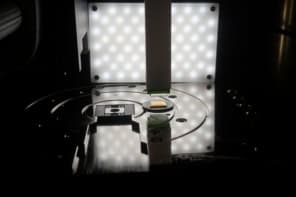Silicon — a staple of modern electronics — could soon be used to make low-cost devices that convert waste heat to electricity. That is the bold future outlined by two independent teams of scientists in the US, who have shown that arrays of tiny silicon wires have extremely good “thermoelectric” properties. The findings could lead to the development of cheap thermoelectric materials that boost the efficiency of both massive coal-fired generators and tiny solar cells.
Many methods of generating electricity — such as burning fossil fuels and nuclear fission — create vast quantities of waste heat. Thermoelectric materials that convert heat directly into electricity could someday be used to recover some of this energy, thereby boosting the efficiency of conventional power stations. Thermoelectric materials could also improve the effectiveness of solar cells and generate electricity from other sources of waste heat such as computer chips and refrigerators.
Low efficiency
Unfortunately, today’s thermoelectric materials are synthetic nanostructures that are very expensive to make and are nowhere near efficient enough to be used commercially.
Some researchers believe that silicon-based thermoelectric materials could overcome these limitations because silicon is easy and inexpensive to work with and has the right electrical properties to be a thermoelectric material. However, silicon is also a good conductor of heat. A thermoelectric material converts a temperature difference across a material into a voltage and silicon’s high thermal conductivity means that a large amount of heat is required to create a small temperature difference — making it a very inefficient thermoelectric material.
Factor of 100
Now, two independent teams in California have worked out a way to boost the thermoelectric efficiency of silicon by as much as a factor of 100. Both results are reported in the journal Nature.
Allon Hochbaum and colleagues at the University of California, Berkeley, created arrays of tiny silicon nanowires by dipping silicon wafers into an aqueous solution of silver ions. The nanowires were 20–300 nm in diameter and the team discovered that arrays have a thermoelectric efficiency about 60 times greater than bulk silicon at room temperature.
Rough surfaces
They believe that this rise in efficiency occurs because heat-carrying sound waves called phonons have a very difficult time moving along the very narrow nanowires, reducing their ability to conduct heat. One important feature of Berkeley nanowires is that their surfaces are rough, which the researchers believe contributes to their high thermoelectric efficiency, although the physics behind this remains unclear.
Meanwhile, at the California Institute of Technology, Akram Boukai and colleagues have seen a similar effect in even smaller rectangular nanowires with cross-sections of 10 × 20 nm and 20 × 20 nm. The team measured a 40-fold boost in efficiency over bulk silicon at room temperature. This increased to a 100-fold boost at -73 °C.
Intriguingly, their observations suggest that another phenomenon — called “phonon drag” — also plays a role in boosting the thermoelectric efficiency. Phonon drag occurs when phonons moving through the silicon collide with charge carriers such as electrons and drag them along.



